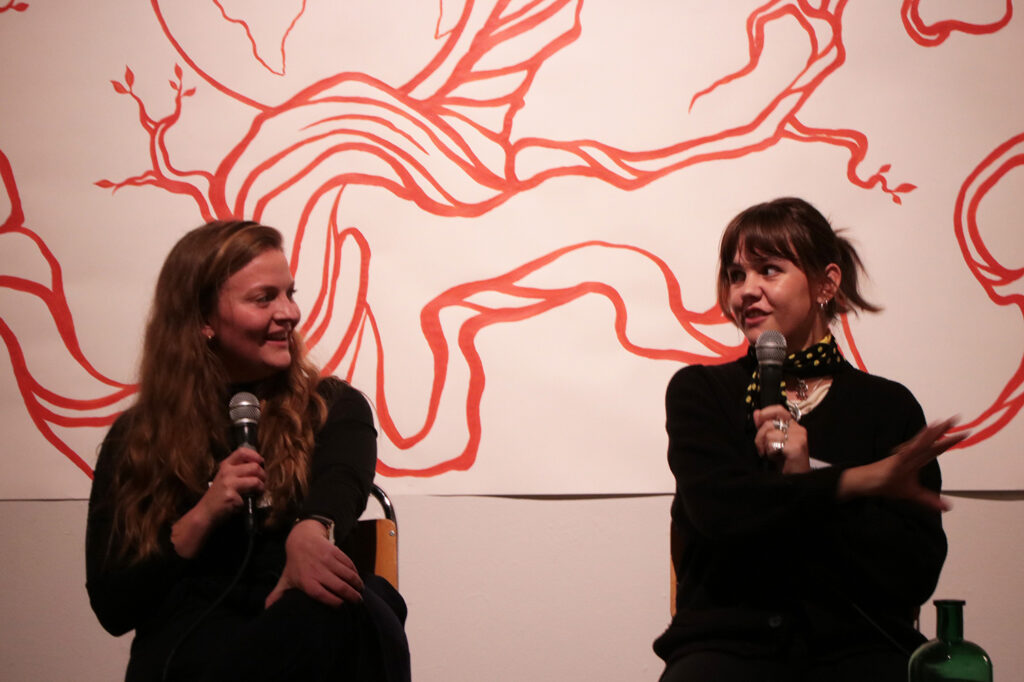“What’s your best food idea?” On 16 October, World Food Day, SIANI organised a creative brainstorming evening in Stockholm together with NGOs, young locals, young politicians, an artist, a chef and two community farmers. Here are lessons on how art, restaurants, politics, and farms can become agents of change.
The event Matskiftet, the Food Shift, was organised by SIANI together with the NGOs The Hunger Project, Reformaten and Momentum Fryshuset. It is part of a broader Matskiftet campaign to share good ideas and co-create new solutions for a better food system. The aim is to demonstrate that change is already happening in many places around the world, but that we need to move faster and learn from each other.
Before the event, 12 ideas from around the world were shared, four of them submitted by SIANI – learn more about them here. The purpose of the evening was to network and brainstorm even more ideas. The artist Smilla Ubbe had created a beautiful orange-pink tree that served as the backdrop to the whole evening, and she encouraged everyone participating to add leaves to the tree with their best ideas for a better food system – leaf-shaped post-it notes were distributed for the purpose. Soon the branches were studded with innovative ideas.
Three panel discussions helped drive the creative process and explore different aspects of change. The first focused on what is really at stake.
Changing our mindsets
Moderated by Reformaten’s Pelle Bengtsberg, Tina Forslund from The Hunger Project, Reformaten’s Olga Grönvall and Ebba Ragnartz from SIANI unpacked what’s wrong with today’s food system. The trio described how the system is broken, causing hunger to increase globally while aggravating climate change, inequality, and biodiversity loss.
Changing the food system is however a complex process, as Ebba pointed out:
“It is not just about generating good ideas, but about changing our mindsets. We need to learn to think differently about how food is produced and consumed.”
The role of politics
The role of politics was explored in a panel discussion with representatives from five of Sweden’s political youth organisations: Lina Fernström (the youth organisation of the Centre Party), Rebecka Forsberg (youth organisation of the Green Party), Louise Hammargren (Christian Democrats’ youth organisation) Hedvig Lindgren (Liberal Youth Organisation), and Lisa Nåbo (the Social Democrats’ youth organisation).
Ebba, Olga and Tina had passed on questions to the politicians about which changes they would like to see and how Sweden can help improve the global food system. Lina Fernström from the Centre Party, traditionally with strong links to Sweden’s farmers, advocated for more locally produced food and reforms to the European Union’s agricultural programme. The Green Youth’s Rebecka Forsberg and the liberal Hedvig Lindgren also called for EU reforms. According to Forsberg, the union’s current system subsidises large-scale, fossil-dependent farms at the expense of smaller and more sustainable alternatives.
Hedvig Lindgren emphasised the need for international collaboration and was seconded by the Social Democrat Lisa Nåbo who wanted to increase Sweden’s international development assistance and gear it more towards food systems. The Christian Democrat Louise Hammargren agreed on the role of international collaboration but felt that Sweden should also increase its self-sufficiency when it comes to food.
The role of art
In a panel discussion led by Esmeralda Sjögren from Momentum Fryshuset, the artist Smilla Ubbe talked about how art can, and must be, a powerful tool for change:
“We need to make better decisions collectively, as a society, and we must work systematically to achieve this. Visuals are very important since they influence how we perceive things and how we act.”
Smilla noted that companies are already working this way. The food industry is playing on emotions to make us buy more, for example using colours like red and orange that drive sales. To change the food system, we can apply similar ways of thinking and use behavioural design and nudges to encourage sustainable habits.
The role of restaurants
Una Hallgrimsdottir is an Icelandic chef devoted to “design, food, farming + things in between”. A critic of mainstream restaurants, she has started a food studio in the Swedish capital Stockholm to do things differently. Her events and workshops should explore food and eating with a creative and critical approach.
“I want to create a space for food that is more sustainable, from different perspectives, focusing also on connecting with your neighbours over food and using wild foods collected in nature.”
The role of food producers
Farming and food production are other critical aspects of the desired food shift. Damir Radovic shared his experiences working with community farming in the Stockholm suburb Rinkeby. Lack of space has been an issue, but his organisation Det gror i betongen has developed mobile garden solutions for public spaces, for example cultivating shiitake mushrooms on logs. He emphasised the many dimensions of food, not least the connection with human rights.
Lily Begg from Alnarp Agroecology Farm in southern Sweden highlighted the role of collaboration in various forms. Alnarp farm offers membership and subscription services, which gives the farm a more reliable income and consumers a stronger connection to the food they eat. Lily also praised collaboration between different sectors like farmers, chefs, artists and others for knowledge exchange and co-creation:
“It’s not about finding one idea that will fix everything, we have become obsessed with “solvability”, we need thousands of ideas to shift the food system, including local and context-specific ideas. And we need to constantly rethink things – what was a great idea three years ago may not work today.”
Leaves of innovation
In addition to a wealth of conversations, the evening produced a tree full of ideas from the participants which will be shared. Examples included “Start a community garden with your neighbours”, “Cook food and learn from old people, my grandma is an expert at pickles, jams and gardening”, “Serve breakfast in schools” and “Dare to believe that change is possible.”
